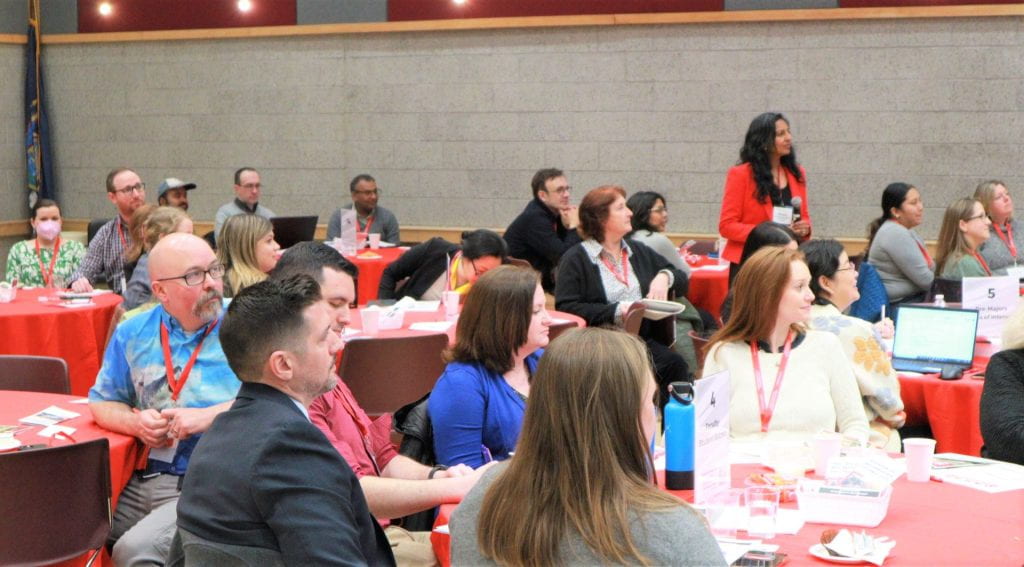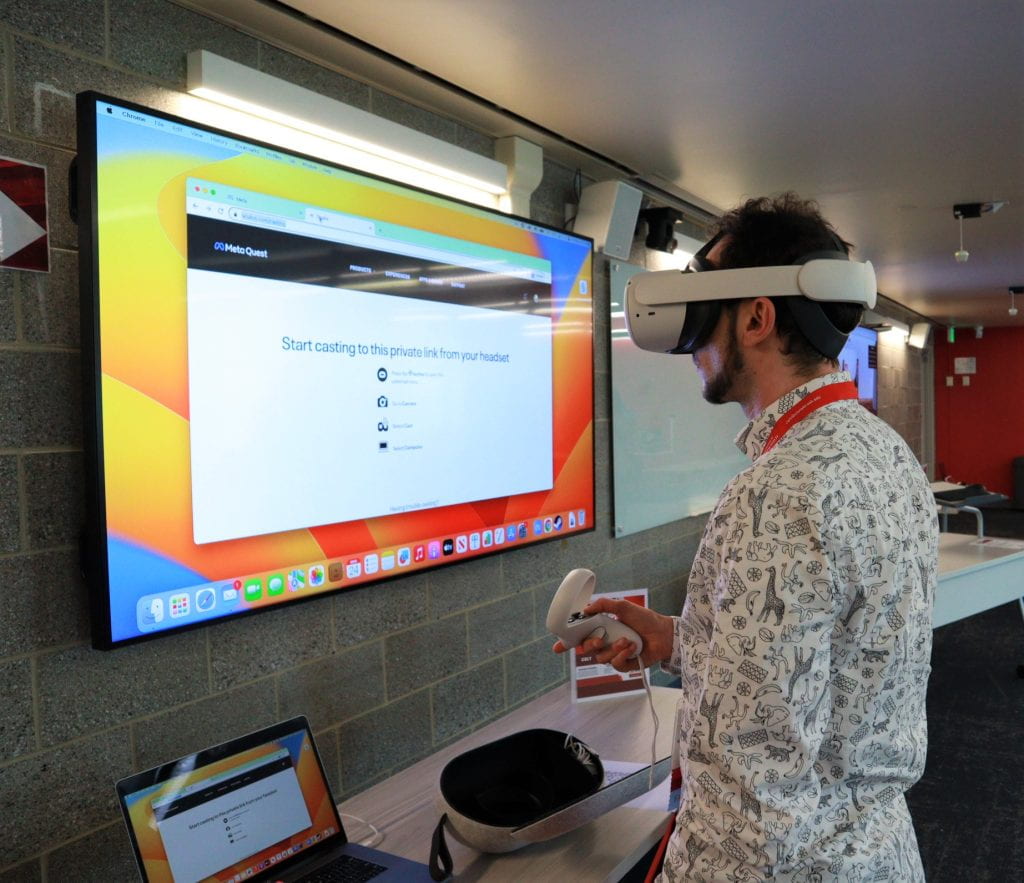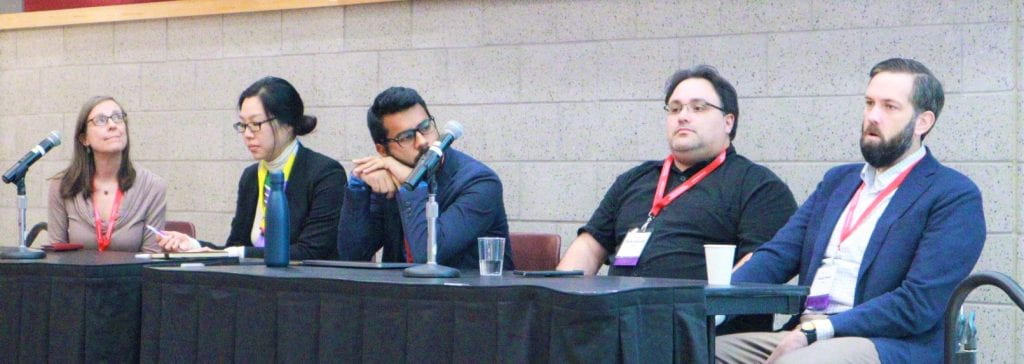By Luis Colon and Jenny Zhang
CELT Instructional Designers
luis.colon@stonybrook.edu and yi.zhang.13@stonybrook.edu

The Center for Excellence in Learning and Teaching (CELT) held a Teaching and Learning Symposium on March 24. The theme for this year’s conference was Transitions. The theme reflects how we navigate across multiple changes, such as those with technologies, learning modalities, and in our teaching practices as we strive to provide a more inclusive environment for students. Close to 100 faculty, graduate students, staff and administrators attended the day-long event in the Student Activities Center. Participants from across the university attended sessions that explored transitions and discussed how to best navigate transitions as we are going through them while also anticipating and preparing for future transitions in higher education.
The event opened with a statement from Dr. Carl Lejuez, Provost and Executive Vice President for Academic Affairs, and promptly launched into the keynote event. Dr. Kelly Hogan and Dr.Viji Sathy presented a highly interactive workshop on Inclusive Teaching that modeled concepts, strategies, and activities that instructors can adopt in their own teaching practice. Both Hogan and Sathy are award-winning instructors from the University of North Carolina who are deeply passionate about student success, equity, and inclusive teaching. They have been featured in national publications such as The Chronicle of Higher Education, The New York Times, and others. Their recently published book, Inclusive Teaching: Strategies for Promoting Equity in the College Classroom, analyzes ways that instructors can design their courses and their teaching practice to help students feel that they are welcome and that they can succeed in the academic space.
The workshop started by bringing attention to how inequities can manifest within the learning environment. To address these inequities, Hogan and Sathy provided practical skills and strategies, saying, “It’s our job to ensure that all students have the ability to succeed.” Concrete examples included: “Provide [lecture] notes with blanks, so students can be prompted to recall and fill in the blanks. Use subtitles, visual prompts, and microphones. Pause in time to give people a chance to construct their ideas.”
Throughout the session, participants were encouraged to reflect on their own teaching experiences and to consider how they could use what they took from this session to reduce inequities in their own courses. Hogan and Sathy kept the workshop interactive by utilizing polling, think-pair-share, and other learning strategies to model the value to engaging learners and to keep the audience focused on the learning objectives of the session. The audience responded positively and many continued discussions later on as the event progressed.
Session One, titled Supporting Students Through Transitions, was led by Dr. Kristin Hall of CELT as well as Brandon Bjertnes, Jennifer Poma, and Jennifer Rodriguez of U-RISE. This session focused on the deluge of changes that higher education has experienced over the years and specifically addressed how to best support the next generation of students as they re-learn how to navigate the in-person learning environment in post-pandemic times. The presenters discussed how the definition of the “traditional college student” has changed as the next generation of college students bring more diversity to higher education institutions nationwide. This session provided strategies to address the different learning needs of these students by understanding how they learn best and prioritizing their success. The presentation combined local university data and research-backed practices to ensure that attendees would be equipped with new strategies that could make a difference in their teaching as soon as they would be implemented.
Following the first session were the Food for Thought concurrent table sessions where attendees would have lunch and the opportunity to seek out a table in the ballroom that would be focusing on a research topic of interest related to teaching and learning. The topics ranged from active learning, the utilization of virtual reality and/or augmented reality, TA training and assessment, and more to provide a space for attendees to delve deeper into topics that were of interest to them and would help them to develop their own practice further. Attendees that I spoke with expressed excitement at the opportunity to have time for discussions with others interested in similar topics and said it was a great experience to either learn new skills or reframe and refine old ones.
Virtual Reality
The CELT virtual reality team showcased the potential of virtual reality (VR) for enhancing education and collaboration through a captivating VR demo session. Held in the Student Activity Center (SAC) 302, the event drew faculty members who were eager to explore various VR applications for teaching and learning. Three interactive stations were set up, offering immersive experiences using 360 videos, WebXR Framevr, and Horizon Workrooms.
Station 1: 360-Degree Video
Mark Lang, a 360-degree video and photo expert at the School of Marine and Atmospheric Sciences (SoMAS), has been revolutionizing education through immersive experiences that enhance student engagement, particularly during the COVID-19 pandemic. Mark’s collaboration with Dr. Darcy Lonsdale led to a virtual field trip to the Rocky Intertidal Zone at Crane Neck Point on Long Island Sound, allowing students to explore marine ecosystems remotely, and learn from Dr. Lonsdale’s narrative at the same time. Mark’s ingenuity in customizing equipment for challenging marine environments has improved the quality of the videos. His station attracted many interested faculty. In that demo, they were transported to a realistic sense of presence, observing the ecosystem through the Oculus headset. Faculty were thrilled to learn how this technology could be utilized to take their students on virtual excursions, making remote and inaccessible locations easily reachable for educational purposes.

Station 2: WebXR Framevr
The second VR station introduced WebXR Framevr, an innovative platform for creating and sharing immersive content. Here, participants took a guided tour of a virtual CELT classroom, complete with interactive whiteboards, 3D objects, and multimedia resources. The experience was not only engaging but also demonstrated how virtual learning environments could help break down geographical barriers and foster collaboration between students and educators from all around the world. The WebXR virtual classroom can be accessed through VR headsets, computers, or tablets, making it a most sustainable VR solution.
Station 3: Horizon Workrooms
The third station allowed faculty to experience Horizon Workrooms, a virtual collaboration tool designed for remote meetings and team building. Participants who donned the Oculus headset or computers can join a virtual business meeting. The immersive environment enabled seamless communication and collaboration, showcasing the potential of VR to revolutionize how we work and learn together.
After testing the different VR experiences, faculty members engaged in discussions about the various features of each technology, as well as the hardware and software setup required. They also brainstormed practical applications for their own classes and considered how to integrate VR into their curriculums best to enhance student engagement and learning outcomes.

Following the break for lunch, participants continued to Session Two, The Rebound After Remote: How Teaching Online has Transformed Current Instruction. This part of the program featured a panel discussion facilitated by Dr. Carol Hernandez and Jenny Zhang of CELT, where faculty discussed what they learned and how they grew professionally as a result of teaching during the COVID-19 pandemic. The panel featured Dr. Anne Moyer from the Department of Psychology, Dr. Daniel Amarante from the Department of Chemistry, Dr. Sohl Lee from the Department of Art, Dr. Kevin Reed from SoMAS, and Anthony Gomez III, who is a PhD candidate in English Literature. The session not only provided a wealth of experiential knowledge but included inspiring anecdotes and stories as the panel shared what kept them motivated during the early days of the pandemic and how the experience allowed them to reflect and adjust their instructional approaches to meet their student’s needs. For the panelists, the time spent learning and growing during the era of remote learning would continue to be valuable to them to this day as many still use these strategies in their current teaching practice.
Session Three, Brightspace: Lessons Learned, was led by Diana Voss and Jennifer Adams of the Division of Information Technology and focused on some of the most impactful teachable moments that they have experienced as the university has shifted to using D2L Brightspace as the learning management system for Spring 2023 and beyond. The session was informative and useful as faculty, TAs, and staff were provided with some of the most useful and popular features in D2L Brightspace to help enhance the learning experience, create an inclusive classroom environment, collect student data, and more. The Q&A section of the presentation allowed the attendees to engage with the presenters and discuss some of the challenges that they have encountered throughout their transition to D2L Brightspace. Attendees either had their questions answered or were able to set up a time where they could consult with someone from the Division of Information Technology to find solutions to these challenges as soon as possible.
Overall, the 2023 Teaching and Learning Symposium delivered on its promise to address transitions in teaching and learning at the higher education level in an environment that celebrated growth and professional development for all. The event provided an open space for faculty, TAs, and staff to engage in discourse related to teaching and learning with their colleagues in a constructive manner. On the topic of education, theologian John Cotton once said that, “Those who teach, must never cease to learn.” That sentiment is as true today as when it was first written. Events such as the CELT symposium ensure that professional learning never ceases and that today’s educators become better each day.
If you’d like to learn more about the CELT Symposium, here is the Google Collaborative Note-Taking Document from the day’s events. If you have notes to share, please feel free to edit and add your notes. Also, here is a reference sheet from the keynote speakers Dr. Kelly Hogan and Dr. Viji Sathy that they shared after their session.
